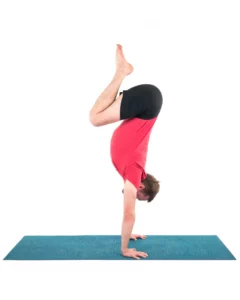Free Yoga Video: Breathing for Pelvic Floor Health: Two Practices to Deepen Your Breath

“Our breath, like our heartbeat, is the most reliable rhythm in our lives. When we become attuned to this constant rhythm, our breath can gradually teach us to come back to the original silence of the mind.” ~Donna Farhi
Breathing affects your respiratory, cardiovascular, neurological, gastrointestinal, muscular, and psychic systems, and also has a general affect on your sleep, memory, ability to concentrate, and your energy levels, notes Donna Farhi in her classic book, The Breathing Book.
Physically, mentally – and spiritually, breathing offers a vehicle for settling mind and body – and, it enables us to connect with deeper levels of awareness.
But deepening the breath is not easy! The more we try, the more we fail and often end up getting all tensed up.
Want to learn how to settle the breath in an effortless way? Check out our 10-minute yoga practice with yoga therapist Leslie Howard.
The Many Benefits of Deep Breathing
In addition to circulating oxygen, deep, diaphragmatic breathing has numerous other important benefits. It helps facilitate parasympathetic functioning, which induces deep relaxation and helps you let go of stress.
In addition, the deep rhythmic movement of the diaphragm stimulates lymphatic function, improves digestion, and helps with the detoxification of the body. Deep breathing also improves blood flow, reduces chronic inflammation, and increases energy and well-being.
But did you know that when we breathe deeply and fully, it also gently stretches and massages the pelvic floor muscles? A toned and balanced pelvic floor is essential to avoid pelvic floor disorders like incontinence, prolapse, and pelvic pain.
When the breath is balanced, the pelvic floor moves in tandem with the diaphragm. When we inhale deeply, the diaphragm pushes the content of the abdomen downwards, and the pelvic floor muscles get stretched gently. When we exhale, the diaphragm moves up, and the pelvic floor muscles release and lift.
Yoga Techniques for Deep Breathing
We all know that diaphragmatic breathing is the best way to gain the full benefits of breathing, but it’s not always easy to let go of deeply engrained breathing habits.
“Breathing patterns are very individual,” says yoga therapist Leslie Howard. “We all have our own unique breathing signature.” For many people, breathing has become shallow due to stress, past trauma held in the body, poor posture habits, or lack of body awareness. Once these breathing patterns become established in the body, it’s not always easy to change them.
In the free yoga video below, Leslie shares two simple yoga techniques for deepening your breath and, as an added bonus, gently stretching the pelvic floor muscles. Click below to view:
Also Check Out Leslie’s Practice Series:



